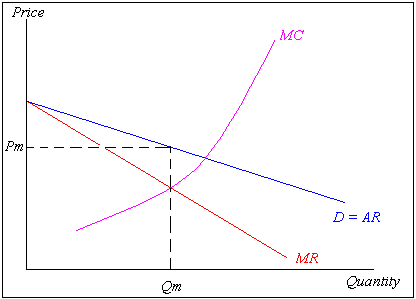Imperfect Competition & Monopoly.
Introduction to microeconomics. | home
Chat room!
Imperfect Competition & Monopoly.
Imperfect competition.Prevails in a market whenever individual sellers have some degree of control over the price of there output.
Monopoly
is the market structure in which only one producer or seller exists for a product that has no close substitutes.
Characteristics of monopolies:
| There is only one firm which supply the entire market and many buyers & consumers |
| The firm sells a unique product, which has no close substitutes. |
| The firm has market power (that is it can control it's price) |
| Entry into the market is restricted, e.g. due to high costs and some special barriers to entry. A social, political or economic impediment, that prevent firms from entering a market. |
These barriers to entry are:
| High cost to enter a market that can support only one business, e.g. the supply of water and electricity etc. |
| A business may have exclusive control of a natural resource. Other producers cannot compete, because they don't have that resource at their disposal. E.g. De Beers controls a large part of all diamond production, and this create a barrier to entry for other firms. |
| A business may have copyright or patent right on it's product, thus making it illegal for other producer to duplicate the product. |
| A monopoly may be created by the state making it legal. |
| A well-known and popular trademark could ensure consumer loyalty, e.g. Pepsi. |
Demand and marginal revenue.
Under pure monopoly, the business is the industry and faces the negatively sloped industry demand curve for the product. This means if the monopolist want to sell more of it's product it must lower it's price. Thus, for a monopolist MR is less than price, and the Marginal Revenue (MR) curve lies below the demand curve.
Monopoly: Short term equilibrium.
Profit maximizing rule: Produce at an output level at which MC = MR.
Finding the monopolist price and output. Steps to follow:
| Find the profit maximizing output level where MC = MR. |
| Extend the line up to the demand curve and down to the X - axis / Q - axis, to determine the output Qm, the monopoly chooses. |
| From the point , where the intersect with the demand curve, extend it horizontally to the P-axis or vertical axis. This will determine the price the monopoly will charge. |

_____________________________________________________________________
Consider the following diagram, which shows the demand and unit loss situation of a monopolist.

What is the output where the firms profits are maximized? - 60.
The price at that output level is - $11.
The average total cost at that output level is - $8.
The profit / loss per unit is : P - ATC = 11-8 = $3
The total revenue at this output is : TR = P ´ Q = $11 ´ 60 = $660
The total cost at that output level is : TC = TVC + TFC = ATC ´ Q = $8 ´ 60 = $480
The total profit / loss at this output level is : TP = TR - TC = $660 - $480 = $180.
_____________________________________________________________________
The social costs of monopoly power.

For a monopolist to maximize profit, the firm should produce at the point, where MR = MC. So that the price and the quality are Pm & Qm respectively. In a competitive market price must be equal to the marginal cost so that competitive price and quantity are Pc & Qc. How will surplus change if we move from the competitive price and quantity to the monopolist price and quantity (from Pc & Qc to Pm &Qm)? Under monopoly the P is higher and the consumer buy less, because of the high price, those consumers who buy a good, loose a surplus of an amount given by the rectangle A. Those consumers who do not buy a good at a price Pm but buy at a price Pc also loose surplus given by the triangle B. The total loss of consumers surplus is therefore : A + B. The producer gains rectangle A by selling at a higher price Pm but looses triangle C, the additional profit it would had earned by selling at Qc & Pc. The total gain in producer surplus is therefore the deadweight loss or social costs from monopoly power are represented by triangles B and C.
Send your comments and suggestions: Cooldosh@mail.ru
Introduction to microeconomics.
Back to the top
